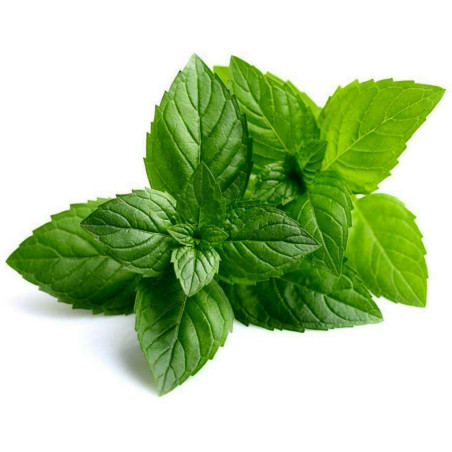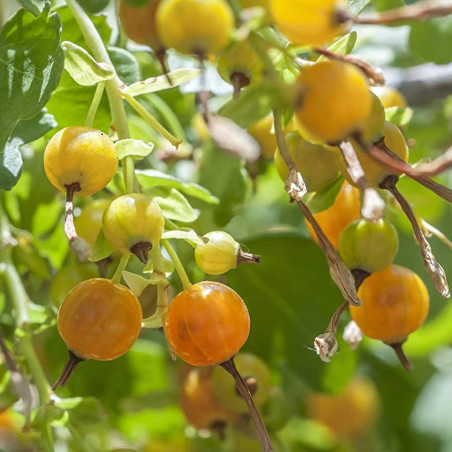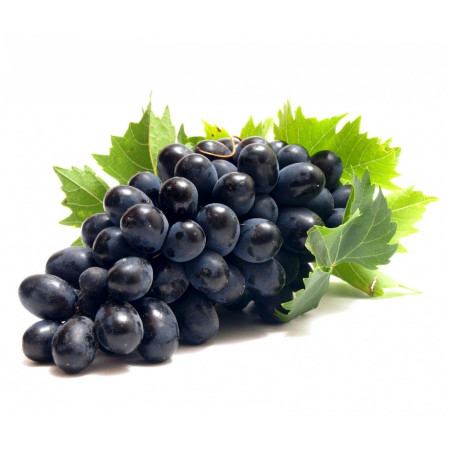
Peppermint Seeds (Mentha piperita)
Peppermint Seeds (Mentha piperita)
Price for Package of 800 seeds.
Peppermint (Mentha × piperita, also known as M. balsamea Willd.) is a hybrid mint, a cross between watermint and spearmint. The plant, indigenous to Europe and the Middle East, is now widespread
Peppermint Seeds (Mentha piperita)
Price for Package of 800 seeds.
Peppermint (Mentha × piperita, also known as M. balsamea Willd.) is a hybrid mint, a cross between watermint and spearmint. The plant, indigenous to Europe and the Middle East, is now widespread in cultivation in many regions of the world. It is found wild occasionally with its parent species.
Culinary and other uses
Pliny the elder, 79 AD, an ancient Roman author, natural philosopher and naval and military commander wrote Naturalis Historia, it tells us that the Greeks and Romans crowned themselves with peppermint at their feasts and adorned their tables with its sprays, and that their cooks flavoured both their sauces and their wines with its essence.
It is the oldest and most popular flavour of mint-flavoured confectionery and is often used in tea and for flavouring ice cream, confectionery, chewing gum, and toothpaste. Peppermint can also be found in some shampoos, soaps and skin care products.
Menthol activates cold-sensitive TRPM8 receptors in the skin and mucosal tissues, and is the primary source of the cooling sensation that follows the topical application of peppermint oil.
Peppermint flowers are large nectar producers and honey bees as well as other nectar harvesting organisms forage them heavily. A mild, pleasant varietal honey can be produced if there is a sufficient area of plants.
Peppermint oil
Peppermint oil has a high concentration of natural pesticides, mainly pulegone (Found mainly in Mentha arvensis var. piperascens Cornmint, Field Mint, Japanese Mint and to a lesser extent-6,530 ppm in Mentha x piperita subsp. nothosubsp. piperita) and menthone.
The chemical composition of the essential oil from peppermint (Mentha x piperita L.) was analyzed by GC/FID and GC-MS. The main constituents were menthol (40.7%) and menthone (23.4%). Further components were (+/-)-menthyl acetate, 1,8-cineole, limonene, beta-pinene and beta-caryophyllene.
Peppermint oil in Irritable Bowel Syndrome (IBS) with constipation
Peppermint oil has also been shown to be effective for IBS with constipation.
Possible medicinal uses
Peppermint has a long tradition of use in folk medicine and aromatherapy. Peppermint is commonly thought to soothe or treat symptoms such as nausea, vomiting, abdominal pain, indigestion, irritable bowel, and bloating, although most of these effects have not been adequately demonstrated in human research.
The aroma of peppermint has been studied for its possible effect to enhance memory and alertness, although other research contests this.
Peppermint oil ingestion by capsules for four weeks may relieve irritable bowel syndrome (IBS) symptoms via an effect on pain sensing fibers.
According to the German Commission E monographs, peppermint oil (as well as peppermint leaf) has been used internally as an antispasmodic (upper gastrointestinal tract and bile ducts) and to treat irritable bowel syndrome, catarrh of the respiratory tract, and inflammation of the oral mucosa. Externally, peppermint oil has been used for myalgia and neuralgia. According to Commission E, peppermint oil may also act as a carminative, cholagogue, antibacterial, and secretolytic, and it has a cooling action.
Enteric-coated peppermint oil capsules (Colpermin) have been used as an orally administered antispasmodic premedication in colonoscopy. The capsules were found beneficial in reducing total procedure time, reducing colonic spasm, increasing endoscopist satisfaction and decreasing pain in patients during colonoscopy.
When peppermint oil antacid products dissolve too quickly, they can sometimes cause heartburn and nausea.
Due to the menthol constituent, topical use of peppermint oil around the facial or chest areas of infants and young children, especially around the nose, can induce apnea, laryngeal and bronchial spasm, acute respiratory distress with cyanosis, or respiratory arrest.
Peppermint oil is also used in construction and plumbing to test for the tightness of pipes and disclose leaks by its odor.
Botany
Peppermint was first described in 1753 by Carl Linnaeus from specimens that had been collected in England; he treated it as a species, but it is now universally agreed to be a hybrid.
It is a herbaceous rhizomatous perennial plant growing to 30–90 cm (12–35 in) tall, with smooth stems, square in cross section. The rhizomes are wide-spreading, fleshy, and bare fibrous roots. The leaves are from 4–9 cm (1.6–3.5 in) long and 1.5–4 cm (0.59–1.57 in) broad, dark green with reddish veins, and with an acute apex and coarsely toothed margins. The leaves and stems are usually slightly fuzzy. The flowers are purple, 6–8 mm (0.24–0.31 in) long, with a four-lobed corolla about 5 mm (0.20 in) diameter; they are produced in whorls (verticillasters) around the stem, forming thick, blunt spikes. Flowering is from mid to late summer. The chromosome number is variable, with 2n counts of 66, 72, 84, and 120 recorded. Peppermint is a fast-growing plant; once it sprouts, it spreads very quickly.
Ecology
Peppermint typically occurs in moist habitats, including stream sides and drainage ditches. Being a hybrid, it is usually sterile, producing no seeds and reproducing only vegetatively, spreading by its rhizomes. If placed, it can grow anywhere, with a few exceptions.
Outside of its native range, areas where peppermint was formerly grown for oil often have an abundance of feral plants, and it is considered invasive in Australia, the Galápagos Islands, New Zealand, and in the United States in the Great Lakes region, noted since 1843.
Cultivation
Peppermint generally grows best in moist, shaded locations, and expands by underground rhizomes. Young shoots are taken from old stocks and dibbled into the ground about 1.5 feet apart. They grow quickly and cover the ground with runners if it is permanently moist. For the home gardener, it is often grown in containers to restrict rapid spreading. It grows best with a good supply of water, without being water-logged, and planted in areas with part-sun to shade.
The leaves and flowering tops are used; they are collected as soon as the flowers begin to open and can be dried. The wild form of the plant is less suitable for this purpose, with cultivated plants having been selected for more and better oil content. They may be allowed to lie and wilt a little before distillation, or they may be taken directly to the still.
Chemical constituents
Peppermint has a high menthol content. The oil also contains menthone and menthyl esters, particularly menthyl acetate. Dried peppermint typically has 0.3-0.4% of volatile oil containing menthol (7-48%), menthone (20-46%), menthyl acetate (3-10%), menthofuran (1-17%) and 1,8-cineol (3-6%). Peppermint oil also contains small amounts of many additional compounds including limonene, pulegone, caryophyllene and pinene.
Germination guide:
1Fill a seed tray with potting soil. Gently tap the seed tray on a hard surface to flatten and evenly distribute the soil.
2Moisten the potting soil lightly with a watering can.
3Sow the mint seeds 1/4 inch deep in the moist potting soil. Place one or two peppermint seeds in each section of the seed tray.
4Water the peppermint seeds lightly. The potting soil should be damp, but not too soggy.
5Cover the seed tray with plastic wrap or plastic film designed for seed trays, which is available at most gardening supply stores.
6Place the seed tray in a sunny and warm place indoors. Peppermint germinates in soil that maintains a temperature of at least 65 degrees Fahrenheit. Sprouts usually begin to emerge between seven and 14 days after planting.
7Water the seeds every few days to keep the soil damp.
8Peel back the plastic wrap once seedlings begin to emerge from the soil. Keep the seed tray in a sunny and warm spot until early spring. Transplant the seedlings outdoors.
| Organic Seeds ? | Organic Seeds |
|---|---|
| Organic/natural ? | Organic/Natural: Yes |
| Edible ? | Edible |
| Germination ? | Germination rate 75% |
| Sowing depth ? | Sowing depth 1 mm |
| Plant is suitable for growing ? | The plant is suitable for growing in a greenhouse The plant is suitable for growing on a balcony-terrace The plant is suitable for outdoors cultivation |
| Suitable for growing in flower pot ? | Suitable for pot: Yes |
| Medicinal Plant ? | Medicinal Plant: Yes |


Aprecierea ta pentru recenzie nu a putut fi trimisa
Reclama un comentariu
Raport trimis
Reclamatia tau nu a putut fi trimisa
Scrie-ti recenzia
Recenzia a fost trimisa
Recenzia ta nu a putut fi trimisa
🌍 Livrare Globală din UE
Expediezăm la nivel mondial din Uniunea Europeană prin poștă recomandată cu confirmare de primire.
📦 Urmărirea coletului
Pentru a găsi numărul de urmărire, autentifică-te în cont și accesează Istoric comenzi > Detalii.
Urmărire globală: 17Track
Pentru numere de urmărire de forma RGxxxxxxHR: Posta.hr tracking
🕒 Notă: Informațiile de urmărire pot deveni disponibile până la 24 de ore după expediere.
⚠️ Observații importante
Plata ramburs nu este disponibilă.
Verifică-ți regulat folderul de spam/junk pentru notificări importante.
Toate întrebările trebuie adresate doar prin formularul de contact de pe site.
Mesajele trimise pe email direct pot să nu fie primite.
📱 Informații necesare la comandă
Te rugăm să introduci întotdeauna numărul tău de telefon mobil cu prefixul internațional.
Exemplu: +40 741 234 567
🚚 Politica de livrare
Coletelor recomandate li se solicită semnătură la primire.
Nu livrăm către:
cutii poștale
vecini
destinatari care nu sunt acasă pentru a prelua coletul
📬 Dacă adresa introdusă este o cutie poștală și coletul este pierdut sau nedisponibil, nu există drept la rambursare.
↩️ Returnări și reexpedieri
Dacă coletul ne este returnat:
Ești responsabil pentru taxa de returnare (2 €)
Și pentru costul reexpedierii
⏱ Întârzieri și urmărire colet
Dacă statusul de urmărire arată că pachetul este încă la expeditor, înseamnă că este în tranzit.
Contactează oficiul poștal local cu numărul de urmărire pentru informații.
Nu suntem serviciu poștal și nu putem urmări coletul în locul tău.
Nu răspundem pentru întârzierile de livrare.
🔍 Putem deschide o investigație pentru colete pierdute doar după 30 de zile de la data expedierii.
✈️ Opțiuni de livrare
| Tip livrare | Timp procesare | Asigurat | Posibile întârzieri | Observații |
|---|---|---|---|---|
| Standard | 7–10 zile lucrătoare | ❌ | 7–14 zile | Opțiune de bază |
| Prioritar | 1–7 zile lucrătoare | ❌ | 3–10 zile | Procesare prioritară, nu livrare mai rapidă |
| Asigurat | 1–7 zile lucrătoare | ✅ | 3–10 zile | Rambursare în caz de pierdere (până la 150 €) |
🕒 Estimare timp livrare:
În UE: 3–20 zile
Global: 5–30 zile
Exemple pentru SUA: 27, 22, 19, 17, 13 zile
💳 Modalități de plată
💶 Transfer bancar (SEPA / IBAN / SWIFT-BIC)
Introdu referința comenzii (ex. SGS-19811702) în descrierea plății.
Lipsa referinței poate duce la întârzieri sau anularea comenzii.
Comenzile se anulează automat dacă plata nu este primită în 7 zile.
🅿️ PayPal
Acceptăm doar plăți în euro (EUR) prin PayPal.
Te rugăm să schimbi moneda în Euro la plată.
💳 Plata cu cardul
Accesează: Exotic Seeds Store
Acceptăm: Visa, MasterCard, American Express, CB, Diners Club, Discover, China UnionPay, JCB și altele.
💡 Clientul suportă toate taxele de tranzacție. Te rugăm să ne trimiți detaliile plății pentru procesarea rapidă a comenzii.
📅 Alte informații
Comenzile nu sunt procesate și expediate în zilele de sâmbătă și duminică.
Te rugăm să consulți întotdeauna anunțurile importante de pe site înainte de plasarea comenzii (vacanțe, condiții speciale etc.).
📫 Pentru întrebări, folosește doar formularul de contact de pe site.
Mesajele trimise direct pe email nu vor fi procesate.
Related Products















